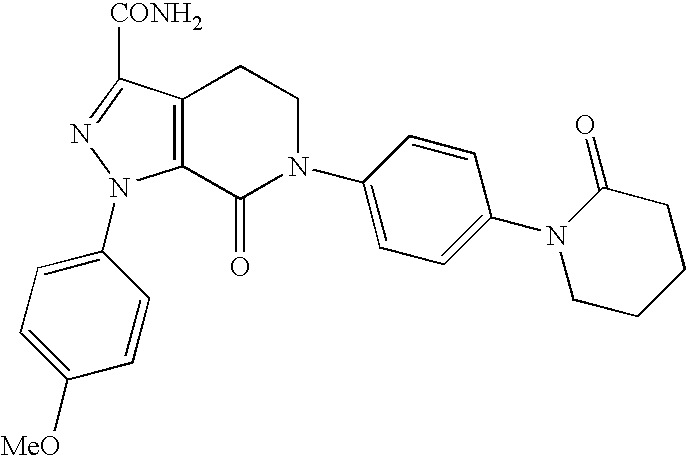Prophylaxis of thromboembolic events in cancer patients
a cancer patient and thromboembolic technology, applied in the field of thromboembolic events in cancer patients, can solve the problems of promoting thrombogenesis, cancer patients bedridden are at risk of thrombosis, and the vessel wall is damaged, and achieve the effect of thrombotic and thromboembolic events
- Summary
- Abstract
- Description
- Claims
- Application Information
AI Technical Summary
Benefits of technology
Problems solved by technology
Method used
Image
Examples
Embodiment Construction
[0015] Apixaban, disclosed in U.S. Pat. No. 6,967,208, which is herein incorporated by reference, has the chemical name 1-(4-methoxyphenyl)-7-oxo-6-[4-(2-oxo-1-piperidinyl)phenyl]-4,5,6,7-tetrahydro-1H-pyrazolo[3,4-c]pyridine-3-carboxamide and the formula
[0016] Additionally, U.S. Pat. No. 6,919,451, U.S. Patent Application Publication No. 2005 / 0245566 A1 and U.S. patent application Ser. No. 11 / 235,510 filed Sep. 26, 2005, which are herein incorporated by reference, disclose various processes and key intermediates for preparing apixaban or a polymorph or pharmaceutically acceptable solvate form thereof.
[0017] As used herein, the term “cancer patient” refers to a warm-blooded animal, such as a mammal, which is afflicted with cancer. It is understood that dogs, cats, rats, mice, and humans are examples of animals within the scope of the meaning of the term. The term “cancer” includes (but not limited to) the following: carcinoma, including (but not limited to) that of lung, breast, ...
PUM
| Property | Measurement | Unit |
|---|---|---|
| time | aaaaa | aaaaa |
| frequency | aaaaa | aaaaa |
| of time | aaaaa | aaaaa |
Abstract
Description
Claims
Application Information
 Login to View More
Login to View More - R&D
- Intellectual Property
- Life Sciences
- Materials
- Tech Scout
- Unparalleled Data Quality
- Higher Quality Content
- 60% Fewer Hallucinations
Browse by: Latest US Patents, China's latest patents, Technical Efficacy Thesaurus, Application Domain, Technology Topic, Popular Technical Reports.
© 2025 PatSnap. All rights reserved.Legal|Privacy policy|Modern Slavery Act Transparency Statement|Sitemap|About US| Contact US: help@patsnap.com

